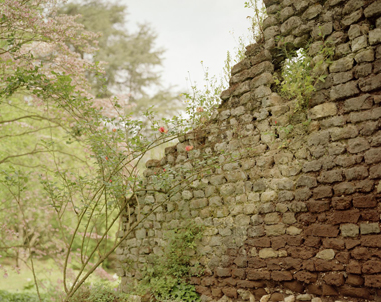
Elger Esser, Ninfa – Physadeia, 2013, Unikat, Directprint, AluDibond, Shellac,
98 x 123 x 4,5 cm, © VG Bild-Kunst, Bonn 2014
Elger Esser
Ninfa
14 Nov 2014 – 31 Jan 2015
opening: Thursday, 13 November 2014, 7 – 9 pm
“Only by way of a nymph does nature become landscape.” – Elger Esser
Galerie Rüdiger Schöttle is proud to present the fifth solo exhibition of German photographer Elger Esser. On view are works from his most recent series of landscape photographs, entitled Ninfa (“nymph”), which were created in the eponymous Italian Giardino di Ninfa, south of Rome.
As the area is particularly well protected at the foot of the Lepini Mountains and at the head of the river Ninfa, an ecosystem with a unique flora and fauna, the origins of which date from Ancient Rome, was able to develop there. Its urban structures were abandoned due to the plague and various crusades in the Middle Ages, and were reconquered by nature. In the 16th century, the aristocratic family of Caetani commissioned the construction of an English Garden around this fertile landscape of ruins. For centuries, the enchantedGiardino di Ninfa has attracted artists, literati and poets – among them Giorgio Vasari, Virginia Woolf, and Gabriele D’Annunzio.
In his examination of Ninfa, Elger Esser focuses on the mythological spirit which inhabits this place. The works have titles such as Orseis, Abarbarea, andNysa, named after the water, rock, and flower nymphs of Greek mythology. In color and in black-and-white, Esser approaches the water- and wildlife sprawling in the ruins and rubble, creating an allegorical set of works which breathes new life into these nymphs.
The high quality of Esser’s one-of-a-kind prints emphasizes the mysterious character of the surroundings in which the works were created. In a special process, the photographs were printed directly on aluminum and coated with Shellac, giving their surface a painterly quality. The photo works are supplemented by video installations which render the movements of the water and its sounds in the Garden more tangible.
Elger Esser (born 1967 in Stuttgart) spent his final school years in Rome. He returned to Germany to study in the famous class of Bernd and Hilla Becher at the Academy of Arts in Düsseldorf (1991–1997). Since then, his landscape images and vedute have been shown in numerous international venues, among them the Solomon R. Guggenheim Museum New York, the Stedelijk Museum Amsterdam, the Kunsthaus Zürich, the Centre Pompidou Paris, and the Lenbachhaus Munich.
Florian Süssmayr
14 Nov 2014 – 31 Jan 2015
opening: Thursday, 13 November 2014, 7 – 9 pm
Hey, Lovers Club, Geyerwally, Lindwurmstrasse, Schelling Salon, U6 Großhadern, Marienplatz, Nein, BC Harta, Ok Girls – these are some of the titles that are typical for the works of Florian Süssmayr. His repertoire ranges from the haphazard – such as his recent series of t-shirts smudged with oil, which he wears when he paints and which manifest both as framed objects and re-portrayed as oil paintings – to hand-picked and staged subjects which often have their origin in everyday life.
One of the artist’s new works shows the back of a woman’s head with classically coiffed hair which anticipates an equally pretty face, the sight of which we are, however, denied. “Betti” is Süssmayr’s version of Gerhard Richter’s almost eponymous painting. Much like its precursor, it is a photorealistic painting which remains reduced to a color palette of shades of white, gray, brown, and black, as Süssmayr’s works frequently do. The artist applies the paint directly and in a single step to the correct spot on the canvas. Florian Süssmayr is a master of this “pinnacle” of the classic disciplines of art.
However, this painting also consists of a second act. Süssmayr’s “Betti” does not wear a quaint flower blazer, but a riveted leather jacket – perhaps a reminiscence of Florian Süssmayr’s punk phase, when he toured with his band Lorenz Lorenz, and a nod to the left-wing autonomous milieu of the 1980s, which he was part of? It is more likely that the artist consciously seeks out a counterpoint to the bourgeois idyll of Gerhard Richter’s portrait. “Fuck the …” is written in large letters on the leather jacket. Here Süssmayr quotes yet another painter, Daniel Richter, a punk among painters. Punk motifs and quotes are present in the works of both artists, and there are also biographical parallels. We read the once controversial and by now politically rather irrelevant slogan, “Fuck the Police,” on a riveted jacket in Daniel Richter’s painting, “Lonely Old Slogan”. The two artists share a rather subversive mindset. It is a joy to see how Florian Süssmayr manages to combine Gerhard Richter’s bourgeois motif with the subject of the rebel Daniel Richter, while remaining genuinely Süssmayr in the process.
Often, Süssmayr’s motifs are not exactly unambiguous. The character of his images changes through layering: Subtitles render his paintings film stills, overpainting makes a landscape scribbling paper, scratches and signs of wear and tear transform a mannerist resurrection scene into a blatant reproduction. Correspondingly, the artist transposes his motifs into various media: A photograph becomes a painting which, in turn, is photographed, photocopied, or printed as a wallpaper to become the background of new images.
A limited edition will be published exclusively for the exhibition.
Amalienstrasse 41 / 80799 Munich
Tues–Fri 11 a.m. – 6.00 p.m. / Sat 12 noon – 4.00 p.m. / Tel. +49 89 333686 / Fax +49 89 342296
info@galerie-schoettle.de
www.galerie-schoettle.de























